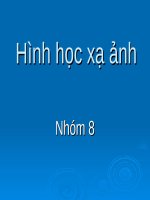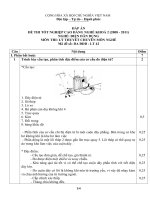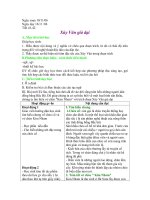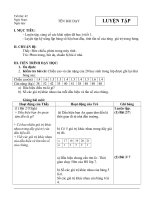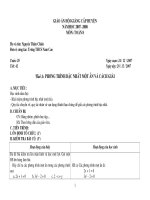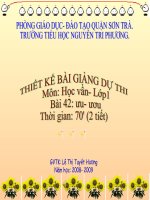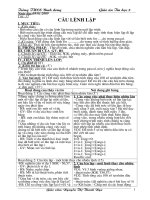PASSAGE 42
Bạn đang xem bản rút gọn của tài liệu. Xem và tải ngay bản đầy đủ của tài liệu tại đây (50.22 KB, 3 trang )
PASSAGE 42
Traditional media come from the people and antecede the mass media; their appeal has historically been
both functional and aesthetic. Whether of roughly-hewn folk origins or of classifically rigid moulds, they
have always served to entertain, educate to reinforce existing ideas or ideologies or to change existing
values and attitudes. In other words, it is a means of changing values, attitudes and norms in order to
provide a proper climate for social and economic progress. It is also a method of promoting certain
behavioural acts or patterns. The aim is to get people to perform specific acts to achieve objectives of
national policy (e.g. visiting clinics, investing in bonds, using fertilizer). Moreover, it is a channel for
conveying information about available techniques and facilities which people may use to solve problems.
Being close to people at the local level, these channels are potentially useful in the service of social
concerns, as determined by local, provincial or national authorities themselves. They are, moreover,
abundantly present in areas where mass media technology has not been fully or effectively developed to
capture sustained interest at local, provincial or national levels. Folk media are personal forms of
entertainment and communication. This is important because behavioural changes are most easily brought
about by personal interaction. These forms of art are a part of the way of life of a community and provide
acceptable means of bringing development issues into the community in its own-terms. They are capable
of reaching intimate social groups, thus making use of already established communication networks in
the audience.
Question 1. Why is traditional media considered the roof of mass media?
A. Because it relates to the minds and hearts of the local population.
B. Because it is a form of a country’s as well as a region’s traditional arts.
C. Because both the local people and foreign visitors like puppetry the most.
D. Because its purpose is art performance and entertainment.
Question 2. What purpose of traditional media is NOT mentioned?
A. Education
B. Entertainment
C. Information dissemination
D. Value reformation
Question 3. What is the easiest way to change a person's behaviour?
A. By personal interaction
B. Through modern entertainment
C. By public speaking
D. By information exchange
Question 4. The phrase “established communication networks” probably refer to _____________.
A. traditional media
B. development issues
C. provincial audience
D. intimate social groups
Question 5. What is the word “hewn” in Paragraph 1 closest in meaning to?
A. known
B. shared
C. shaped
D. reflected
Page 1
ĐÁP ÁN
1-A
2-C
3-A
4-D
5-C
LỜI GIẢI CHI TIẾT
Question 1:
Tại sao truyền thông truyền thống được coi là mái nhà của phương tiện truyền thơng đại chúng?
A. Bởi vì nó liên quan đến tâm trí và trái tim của người dân địa phương.
B. Bởi vì nó là hình thức của một quốc gia, cũng như một khu vực nghệ thuật truyền thống.
C. Vì cả người dân địa phương và du khách nước ngồi thích múa rối nhất.
D. Vì mục đích của nó là biểu diễn nghệ thuật và giải trí.
=> Dẫn chứng: Traditional media come from the people and antecede the mass media; their appeal has
historically been both functional and aesthetic.
Dịch: Phương tiện truyền thông truyền thống đến từ người dân và là tiền sử các phương tiện truyền thông
đại chúng; sự hấp dẫn của chúng trong lịch sử là cả chức năng và thẩm mỹ.
Question 2:
Mục đích của truyền thơng truyền thống KHƠNG được đề cập?
A. Giáo dục
B. Giải trí
C. Phổ biến thơng tin
D. Cải cách giá trị
=> Dẫn chứng: Whether of roughly-hewn folk origins or of classifically rigid moulds, they have always
served to entertain, educate to reinforce existing ideas or ideologies or to change existing values and
attitudes.
In other words, it is a means of changing values, attitudes and norms in order to provide a proper climate
for social and economic progress.
Dịch: Cho dù có nguồn gốc dân gian thơ sơ hoặc khn mẫu cứng nhắc, chúng ln phục vụ để giải trí,
giáo dục để củng cố các ý tưởng hoặc ý thức hệ hiện có hoặc để thay đổi các giá trị và thái độ hiện có.
Nói cách khác, nó là một phương tiện thay đổi các giá trị, thái độ và chuẩn mực để cung cấp một mơi
trường thích hợp cho tiến bộ xã hội và kinh tế.
Question 3:
Cách dễ nhất để thay đổi hành vi của một người là gì?
A. Bằng cách tương tác cá nhân
B. Thơng qua giải trí hiện đại
C. Bằng cách nói trước cơng chúng
D. Bằng cách trao đổi thông tin
=> Dẫn chứng: Folk media are personal forms of entertainment and communication. This is important
because behavioural changes are most easily brought about by personal interaction
Dịch: Phương tiện truyền thơng dân gian là hình thức giải trí và truyền thơng cá nhân. Điều này rất quan
trọng vì những thay đổi hành vi dễ dàng mang lại bởi sự tương tác cá nhân
Question 4:
Cụm từ “được thiết lập mạng truyền thơng”, có lẽ đề cập đến ____________.
A. truyền thơng truyền thống
B. vấn đề phát triển
C. khán giả tỉnh
D. nhóm xã hội thân mật
Page 2
=> Dẫn chứng: These forms of art are a part of the way of life of a community and provide acceptable
means of bringing development issues into the community in its own-terms. They are capable of reaching
intimate social groups, thus making use of already established communication networks in the audience.
Dịch: Những hình thức nghệ thuật này là một phần trong lối sống của một cộng đồng và cung cấp các
phương tiện có thể chấp nhận để đưa các vấn đề phát triển vào cộng đồng theo cách riêng của nó. Họ có
khả năng tiếp cận các nhóm xã hội thân mật, do đó tận dụng các mạng truyền thơng đã được thiết lập
trong khán giả.
Question 5:
Từ " hewn " trong Đoạn 1 gần nhất có nghĩa là gì?
A. biết
B. chia sẻ
C. hình
D. phản ánh
Whether of roughly-hewn folk origins or of classifically rigid moulds, they have always served to
entertain, educate to reinforce existing ideas or ideologies or to change existing values and attitudes
Dịch: Cho dù có nguồn gốc dân gian thơ sơ hoặc khuôn mẫu cứng nhắc, họ luôn phục vụ để giải trí, giáo
dục để củng cố các ý tưởng hoặc ý thức hệ hiện có hoặc để thay đổi các giá trị và thái độ hiện có= shaped
(hình thành bởi)
Page 3
